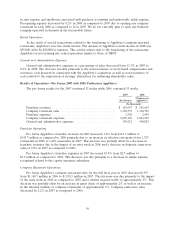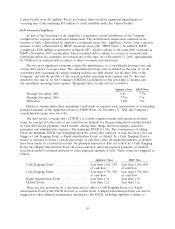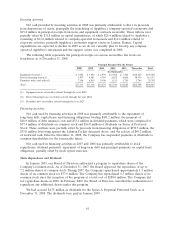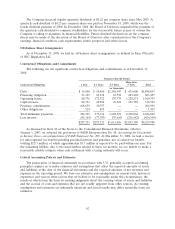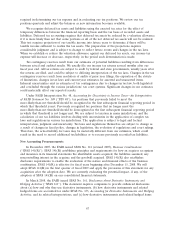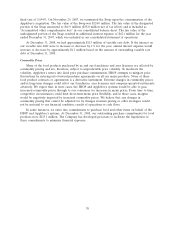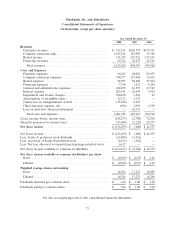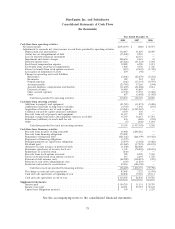IHOP 2008 Annual Report Download - page 80
Download and view the complete annual report
Please find page 80 of the 2008 IHOP annual report below. You can navigate through the pages in the report by either clicking on the pages listed below, or by using the keyword search tool below to find specific information within the annual report.SFAS No. 149, Amendment of Statement 133 on Derivative Instruments and Hedging Activities. The
standard requires that all derivative instruments be recorded on the balance sheet at fair value and
establishes criteria for designation and effectiveness of the hedging relationships.
We use derivative financial instruments primarily for purposes of hedging exposures to fluctuations
in interest rates. All derivatives are recognized on the balance sheet at fair value. For derivative
instruments that are designated and qualify as a cash flow hedge (i.e., hedging the exposure to
variability in expected future cash flows that is attributable to a particular risk), the effective portion of
the gain or loss on the derivative instrument is reported as a component of other comprehensive
income or loss and reclassified into earnings in the same line item associated with the forecasted
transaction in the same period or periods during which the hedged transaction affects earnings (for
example, in ‘‘interest expense’’ when the hedged transactions are interest cash flows associated with
debt). The remaining gain or loss on the derivative instrument in excess of the cumulative change in
the present value of future cash flows of the hedged item, if any, is recognized in other income/expense
in current earnings during the period of change.
At inception of the hedge, we choose the Hypothetical Derivative Method of effectiveness
calculation, which we must use for the life of the contract and we will measure effectiveness quarterly.
When hedge treatment is achieved under SFAS 133, the changes in fair values related to the effective
portion of the derivatives are recorded in other comprehensive income or loss or in income/expense,
depending on the designation of the derivative as a cash flow hedge. We obtain the values on a
quarterly basis from the counterparty of the derivative contracts. The undesignated portion of the
derivative contract is calculated and recorded in Company’s Consolidated Statements of Operations at
the end of each quarter until settled.
Fair Value Measurements
Effective January 1, 2008, the Company determines the fair market values of its financial assets
and liabilities, as well as non-financial assets and liabilities that are recognized or disclosed at fair value
on a recurring basis, based on the fair value hierarchy established in SFAS No. 157, Fair Value
Measurements (‘‘SFAS No. 157’’). We measure our financial assets and liabilities using inputs from the
following three levels of the fair value hierarchy. The three levels are as follows:
• Level 1 inputs are unadjusted quoted prices in active markets for identical assets or liabilities
that we have the ability to access at the measurement date.
• Level 2 inputs include quoted prices for similar assets and liabilities in active markets, quoted
prices for identical or similar assets or liabilities in markets that are not active, inputs other than
quoted prices that are observable for the asset or liability (i.e., interest rates, yield curves, etc.),
and inputs that are derived principally from or corroborated by observable market data by
correlation or other means (market corroborated inputs).
• Level 3 includes unobservable inputs that reflect our assumptions about the assumptions that
market participants would use in pricing the asset or liability. We develop these inputs based on
the best information available, including our own data.
For more information on the financial instruments the Company measures at fair value, see
Note 13, Fair Value Measurements.
Income Taxes
We provide for income taxes based on our estimate of federal and state income tax liabilities. Our
annual tax rate is based on our income, statutory tax rates and tax planning opportunities available to
us in the various jurisdictions in which we operate. Tax laws are complex and subject to different
interpretations by the taxpayers and respective governmental authorities. Significant judgment is
66


